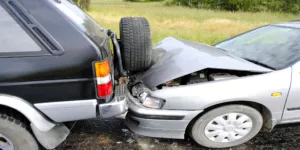You’re driving to work, carefully paying attention to the road, when suddenly, out of nowhere, another car slams into your side. The other driver ran a stop sign. Now your car is wrecked, and you’re not sure if you’re injured.
At least the accident wasn’t your fault. The other driver’s insurance will cover your repair and medical costs. But what if the other driver doesn’t have insurance?
What to Do if You’re in an Accident with an Uninsured Motorist?
What should you do if you’re in an accident with an uninsured motorist? The process is essentially the same as with any other accident, but you’ll need to let your insurance company know that the other driver doesn’t have coverage.
1. Call the Police
With any accident, the first step is to call the police. This step is even more critical when you’re involved in an accident with an uninsured motorist.
Having a police and accident report will support your case, and may help you recoup money for repairs and medical care.
Also, take photos of the accident scene, the damage and the location of the accident. Photograph skid marks and any other details of the accident scene.
2. Exchange Information
The police will get the other driver’s information, but you want to get this information as well. Get all of the information you can about the other driver and the vehicle. This may be the stage where you find that the other driver doesn’t have any insurance coverage.
Make it a point to also gather the information of any witnesses at the scene.
3. Contact Your Insurance Company
Contact your insurance company, and let them know about the accident. What the insurance company can do will depend on your policy and the extent of the damage.
If you have the right coverage, your insurance company will cover the cost of repairs and your medical care. If you don’t have the right coverage, your insurance agent should be able to tell you what to do next.
4. Get Medical Attention
Your health is your top priority. Get medical attention, even if you don’t think anything is wrong. Sometimes, injuries don’t show up for days.
Your health insurance may cover the costs, or you may be stuck with paying the deductible.
If you have the right coverage, your insurance company will cover medical bills, lost wages and other costs that the other driver’s insurance company would have covered.
5. Get Your Car Repaired
If your car is damaged, talk to your insurance company about what you can do to get it fixed. If you have the right coverage, the cost of the damage will be covered by your insurer.
If you can’t get the repairs covered through your insurance company, you can seek compensation through other avenues, like the courts. This can get tricky, and you’ll need a lawyer if you go this route. If the other driver has no assets, you’ll walk away with nothing.
The Importance of Uninsured Coverage and Underinsured Coverage
Nearly every insurance company offers uninsured and underinsured coverage, but keep in mind that this is usually not part of a standard policy. You will likely have to purchase this coverage separately, but it is worth the extra cost.
- Uninsured Coverage: Uninsured coverage will cover repairs and medical care if you are in an accident with a driver who has no insurance coverage.
- Underinsured Coverage: Underinsured coverage will cover the difference if you’re hit by a driver that carries insufficient car insurance.
“Many people assume that if they are in an accident with an uninsured motorist, they cannot recover compensation for their injuries, but this is not necessarily the case,” says Queener Law (https://queenerlaw.com/). “In fact, you are likely entitled to compensation under the uninsured motorist coverage provided through your own insurance policy.”
The Uninsured or Underinsured Claims Process
If you have uninsured coverage, it’s important to let your insurance company know that you’ll be filing an uninsured claim as soon as possible. Some insurers have strict deadlines on when policyholders need to notify them of potential uninsured claims. That deadline may be as short as 30 days.
If you know the other driver doesn’t have insurance coverage or refuses to give you insurance information, let your insurance company know right away.








